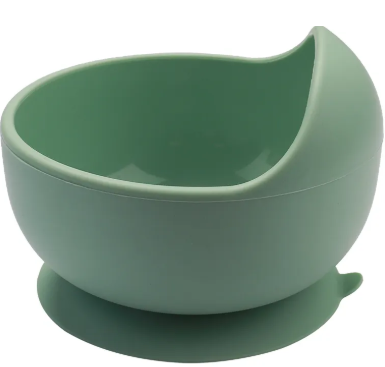Key Factors Affecting Silicone Bowl Durability
Material Quality and Food-Grade Standards
Material quality significantly influences the durability of silicone bowls, particularly in their ability to prevent leaching of harmful chemicals. High-grade silicone that meets FDA food-grade standards ensures user safety while extending product longevity. Certifications such as LFGB and FDA are essential indicators of a product's compliance with food safety standards, thus guaranteeing the silicone's durability. Utilizing inferior-quality silicone can result in degradation and potential health risks, as demonstrated by studies on chemical leaching from low-grade silicone. Always opt for certified Products to ensure safe and long-lasting use of silicone bowls.
Temperature Resistance and Heat Tolerance
Understanding the temperature resistance and heat tolerance of silicone bowls is crucial for maximizing their durability. High-quality silicone bowls can typically withstand temperatures from -40°C to 230°C, surpassing many other materials in heat resistance. Despite this robustness, frequent exposure to extreme temperature fluctuations can lead to material degradation over time, potentially shortening the product's lifespan. For optimal durability, users should avoid subjecting silicone bowls to prolonged high temperatures or direct flames. By adhering to recommended usage conditions, silicone bowls can maintain their integrity and continue to serve efficiently for years.
Flexibility vs. Structural Integrity
Balancing flexibility and structural integrity plays a pivotal role in a silicone bowl's durability. Silicone's natural elasticity offers convenience but excessive flexibility can compromise structural integrity, leading to deformation over time. Such deformation affects functionality and longevity, causing the bowl to lose shape. For example, expert anecdotes highlight failures in overly flexible silicone products, which compromise utility and lifespan. Choosing bowls with an optimal balance of flexibility and sturdiness ensures long-lasting durability while retaining the practical benefits of silicone's innate pliability.
Silicone vs. Other Materials: A Durability Comparison
How Silicone Stacks Up Against Plastic
Silicone bowls offer a significant advantage over plastic when it comes to durability and environmental impact. While plastic bowls are prone to cracking and warping when exposed to high temperatures, silicone withstands extreme conditions, remaining resilient and maintaining its shape even at temperatures up to 482°F (250°C). This difference is crucial, as plastic's susceptibility to damage can lead to premature failure. Additionally, silicone is more eco-friendly since it does not end up in landfills like plastic—an advantage acknowledged by consumers concerned about the environment. Feedback often highlights silicone's long-lasting nature and its resistance to common plastic issues like warping and chemical leaching. This makes silicone a preferred choice for many households prioritizing both performance and sustainability.
Durability Differences with Stainless Steel
When comparing silicone to stainless steel, both materials show distinct strengths and weaknesses. Stainless steel is known for its robustness and resistance to issues like rusting or scratching, offering a long-lasting solution for kitchenware. However, it can be prone to bending and may not provide the same resilience to impacts as silicone. Silicone, on the other hand, strikes a balance between flexibility and durability, resisting deformation and retaining its structural integrity under various conditions. Market trends indicate a shift towards silicone for applications where its flexibility and resistance to extreme conditions are beneficial, such as bakeware and baby products. This preference is due to silicone's non-reactive nature and the absence of rusting or scratching concerns, making it a reliable choice for consumers seeking durability without compromising on user-friendliness.
Safety Considerations Linked to Durability
Chemical Stability Over Time
Chemical stability is a key factor in the longevity and safety of silicone bowls, as it determines whether harmful substances could be released over time. Research indicates that silicone maintains its structural integrity even at high temperatures, making it less likely to degrade and release toxins compared to some plastics. However, it's important to regularly assess silicone products for any signs of degradation. Changes in texture or color can signal instability, which might compromise safety if not addressed. Staying informed about studies and product ratings can help consumers make educated choices regarding the safety of their silicone bowls.
Avoiding Wear-Related Hazards
Wear-related issues such as cuts, tears, or hard-to-clean areas on silicone bowls can pose safety risks by harboring bacteria. Identifying wear early is crucial to maintaining the safety of these bowls. To minimize risks, consumers should regularly inspect their silicone bowls for any signs of damage and follow maintenance strategies, such as avoiding abrasive cleaning methods. Expert recommendations also suggest setting a regular schedule for these inspections to ensure that all potential hazards are addressed swiftly. By practicing these tips, the chances of encountering wear-related hazards are significantly reduced.
Maintenance Tips to Enhance Longevity
Proper Cleaning Techniques
Proper cleaning techniques are crucial to maintaining the durability of silicone bowls. It's recommended to avoid using abrasive sponges which can scratch the surface, and instead, opt for soft cloths or sponges along with non-toxic, mild dish soap. Abrasive materials can lead to deterioration over time, causing build-up that might lead to discoloration. Such issues not only affect the aesthetic appeal but can also compromise the material's integrity. According to industry guidelines, sticking to gentle cleaning methods not only retains the color vibrancy but also prolongs the life span of your silicone products. Regular inspections for any residues or unusual odors can be beneficial in ensuring optimal hygiene and appearance.
Storage Best Practices
Storing silicone bowls under optimal conditions is pivotal for their longevity. Avoiding exposure to extreme temperatures is advised, as such conditions can lead to deformation, which is evident in testimonials from various silicone product users. Therefore, it's crucial to stack these items carefully, ensuring they are not placed under heavy objects. Here is a quick list of do's and don'ts for storing silicone products effectively:
Do's:
- Store in a cool, dry place.
- Ensure they are clean and dry before storing.
- Stack bowls carefully to prevent bending or warping.
Don'ts:
- Avoid extreme temperature changes.
- Do not place on uneven surfaces.
- Refrain from placing heavy objects on top to maintain shape.
By adhering to these best practices, you ensure that your silicone bowls remain durable and functional for a prolonged period, retaining their shape and usability.
Addressing Common Durability Concerns
Preventing Stains and Odor Retention
Silicone bowls, while popular for their durability and safety, often encounter issues related to stains and odor retention. Certain food types, especially those with rich colors or high acidity, can leave persistent marks on silicone surfaces. Furthermore, improper cleaning methods, such as not rinsing thoroughly or using inappropriate detergents, can lead to lingering odors. To tackle these concerns, it is advisable to immediately rinse the bowl with warm water after each use and utilize a mild, non-toxic detergent. Adding a mixture of vinegar and baking soda can effectively eliminate stubborn stains and neutralize odors, as many users have noted in their experiences. Additionally, selecting silicone bowls designed with stain-resistant coatings can further enhance their resistance to discoloration and odor retention.
When to Replace Your Silicone Bowls
Knowing when to replace your silicone bowls is crucial for both durability and health considerations. Common signs that indicate the need for replacement include visible cracks, significant fading, or rough textures that weren't present initially. Such damages not only compromise the bowl’s performance but can also pose health risks as they might harbor bacteria or release small particles into food. According to experts, the recommended lifespan for silicone products is generally around two to five years, depending on usage intensity and maintenance. Paying attention to these signs ensures that you maintain the integrity of your tableware and uphold health standards. Such diligence enhances meal safety, providing users with clear guidelines on silicone product lifespans.
FAQ
What are the benefits of using silicone bowls over plastic?
Silicone bowls are more durable and eco-friendly compared to plastic. They withstand higher temperatures and do not warp or crack, making them a long-lasting option. Additionally, silicone does not contribute to landfill waste like plastic does.
How can I prevent my silicone bowls from retaining odors?
To prevent odor retention, rinse your silicone bowls immediately after use, use mild detergent, and occasionally clean with a mixture of vinegar and baking soda.
When is it time to replace my silicone bowls?
You should consider replacing your silicone bowls if you notice visible cracks, discoloration, or rough textures that could harbor bacteria.


